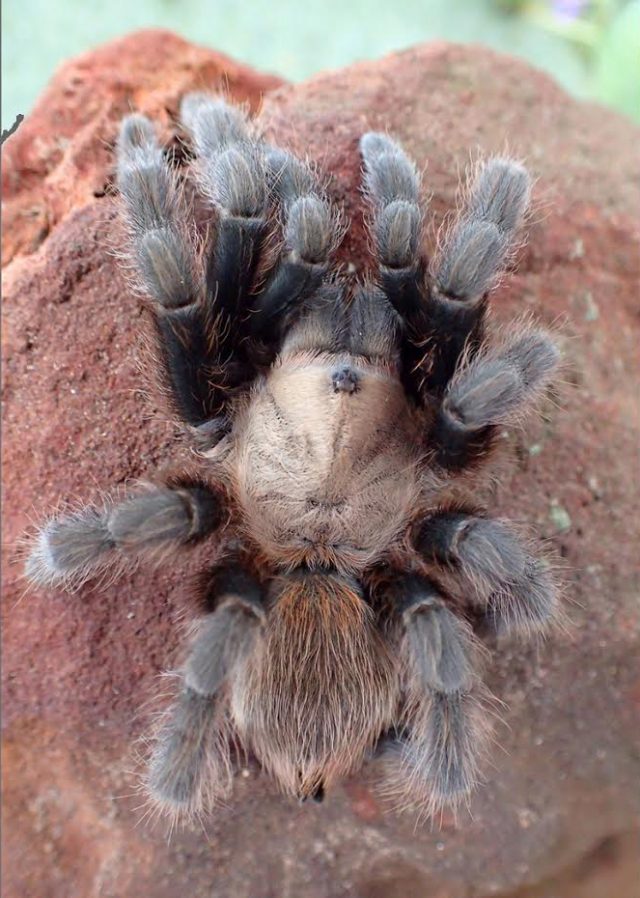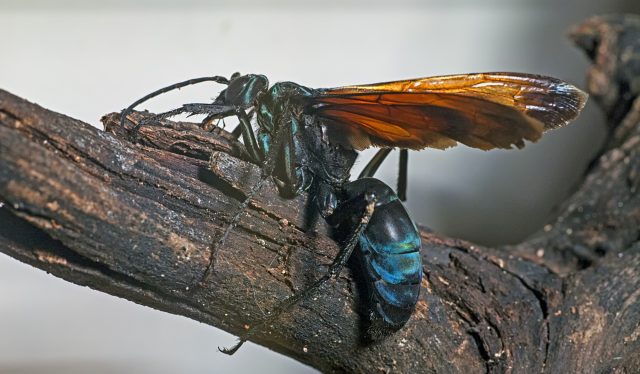06/09/2017 – A Tarantula’s Worst Nightmare (Karen Benson)

Tarantulas are large bodied, eight-legged, primitive spiders common to the southwestern part of the United States. At about three inches across and very hairy, they spark fear in many people. However, they are “gentle giants” for the most part and are often kept as pets. Robert Benson Photo.
A Tarantula’s Worst Nightmare
You don’t have to have arachnophobia to get the weebie-jeebies when you see a tarantula. They are big (for a spider), brown, and extremely hairy. I think humans have a built-in fear of any animal that is hairy, brown, and bigger than others of its kind. Just imagine what you would feel when you see a strange big dog, or a grizzly bear, or Sasquatch for that matter. You don’t feel particularly inclined to reach out and pet it. At least not at first.
Of course, there are people who keep tarantulas as pets. I personally think these folks are not in their right minds. However, they claim that the big spiders are “gentle giants.” They say they can train their tarantula to come for food, to be stroked, and to go into a cup for transport while its terrarium is being cleaned. I suppose this is all true, but I am not inclined to get a tarantula anytime soon.
Tarantulas are common in the southwest quarter of the United States. They typically dwell in “natural cavities under logs or stones or under the loose bark of trees.” In addition, they can make their own burrows in the ground. Sometimes the burrow is a repurposed rodent nest. Tarantulas line the burrow with spider silk. A few strands of silk carpet the ground in front of the burrow. If a prey item, such as a cricket, a June bug, or grasshopper, touches the silk mat, the tarantula rushes out to catch it. Tarantulas spend most of their time in these burrows waiting for prey to come to them. However, they will forage out a few feet if needed.

The Tarantula Hawk is actually a wasp, the largest wasp in North America. It preys on tarantulas, not for food for itself but for its larvae. It rarely stings humans, but if it does, the sting is said to be one of the most painful in the world. Robert Benson Photo.
You may have seen a tarantula above ground after a hard rain. If its burrow is flooded, it may be driven out into the open for a while. Tarantulas also come out to mate. Males wander widely in search of females who usually stay fairly close to their burrows. When a male tarantula locates a female, he approaches her with his front legs raised. He grabs her by her fangs and then bends her backwards. He sways and taps her abdomen repeatedly. Then he transfers a sperm packet he has stored in one of his two palps (little front legs) to a furrow on the female’s abdomen.
Mating accomplished, the female lays 100 to 1,000 eggs in a little silken hammock she has constructed. She covers over the top of the hammock with more silk to make an egg sac. The female guards the egg sac, sometimes even holding it, in the quiet of her burrow for 45 to 60 days. Hatching occurs in July or perhaps a bit later in the year. The spiderlings stay with the female for a few days before dispersing to build their own burrows. Sadly, many of the young tarantulas fall prey to other predators as they disperse.
If disturbed, a tarantula’s first response is to rise up on its hind legs and stretch out its front legs in a threatening manner. It faces its attacker and glares with is eight eyes. Tarantulas have another weapon as well. On the back of their abdomens is a patch of “urticating hairs” that they can dislodge with their hind legs. The tarantula throws these hairs at its attacker. The urticating hairs irritate the tender skin and eyes of vertebrates (including humans) and they usually leave the spider alone after that.
Owners of tarantulas should be especially cautious of urticating hairs. If a tarantula is disturbed (by cleaning its cage, for instance) the creature can kick off some those hairs on its back. The microscopic hairs are like fiberglass threads. They can embed into an owner’s eyes or mucous membranes and can cause severe irritation. The person afflicted may not realize it for a week or more as the barbed hairs work their way into delicate tissues.
In the wild, tarantulas have their own problems. A parasitic wasp known as a Tarantula Hawk preys on adult tarantulas. The wasp jiggles the silk strands at the entrance to a burrow. When the tarantula comes out to check on the disturbance, the Tarantula Hawk stings it. The toxin injected paralyzes the victim. Permanently. The wasp drags the body to a brood chamber (it might be the tarantula’s own burrow) where it lays a single egg on the abdomen of the tarantula. The wasp egg hatches and the larva proceeds to dig into the live but paralyzed spider, consuming only non-vital organs until the last. Finally, it pupates in the abdomen of the victim emerging as an adult a few days later. What a horror story!
Tarantula Hawks are large by wasp standards, about two inches long. The electric-blue body and rust-colored wings are distinctive. The bright colors also serve as warning that the Tarantula Hawk has a powerful sting. In fact, the sting is said to be one of the most painful in the world, second only to that of Bullet Ants. If you want a visual reminder of how bad a Tarantula Hawk’s sting can be, watch Coyote Peterson’s YouTube video at http://youtube.com/watch?v=MnExgQ81fhU
If you can watch that video all the way through, you can imagine how a tarantula might feel after an attack by a Tarantula Hawk. Truly, a Tarantula Hawk has to be the tarantula’s worst nightmare!
